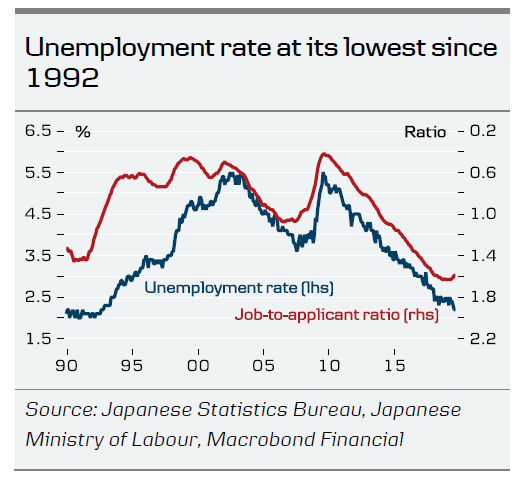- We expect the Bank of Japan (BoJ) to keep the policy rate and yield curve control unchanged at the next monetary policy meeting ending on Thursday 31 October. However, it is set to make great efforts to highlight its willingness to act if needed.
- The economy is still solid, which calls for patience considering the limited tools left at the BoJ’s disposal.
- VAT-hike and global slowdown pose a risk that the economy falls back into deflation.
- We expect the new projections for GDP and inflation to be revised down.
- We continue to weigh the structural appreciation pressure (as inflation remains extremely weak) against cyclical trends, which at least in recent months have been in favour of a weaker JPY. We currently target 107 short term.
Solid economy waiting for risk factors to play out
Overall, the economy is still strong. Domestic demand is solid. The labour market is historically tight and the service sector has held up well on the back of decent household consumption, strong investments and an accommodative fiscal stance. Supermarket scanner data imply consumption is affected more severely than expected by the BoJ (see FT: Japan data point to bigger than expected hit from sales tax rise). October flash PMIs also took a turn for the worse, with service pulling the composite PMI below 50. That said, the typhoon that hit big parts of the country a few weeks ago might be distorting the data and we will need more information on Q4 before any conclusions can be drawn. Consumers’ reaction to the VAT-hike will be important to watch for policy makers, though. We expect the updated projections for both GDP and inflation to be revised down for the coming years, while the FY2019 GDP forecast will likely be revised up on the back of a strong year so far.
A strengthening of the JPY of about 4% y/y poses a headwind for exporters along with the global slowdown, which has caused a decline in demand for especially semiconductor manufacturing parts. Even so, export volumes were up 2.7% y/y in September and we expect GDP-growth around 1.5% q/q annualised in Q3.
As risk factors unfold, the tide could turn, though. The global economic outlook is a big risk for Japan. The US-China trade war is key, with the US and China as the two most important trading partners but the course for global monetary policy could be just as important. With an economy running on the safe-haven JPY, Japan is sensitive to the decisions of the Fed, the ECB and PBoC. On the one hand, there is a risk that global easing forces the JPY stronger, when BoJ will not be able to respond fully to easing measures abroad. However, BoJ also faces the risk that the global monetary policy response is not sufficient to curb a threatening downturn in economic activity in which case we have a global recession and an unsustainable situation for Japanese exporters who face declining global demand enforced by further JPY strengthening causing a deterioration of competitiveness. We believe the latter is the biggest risk.
Likely mulling tweaks to the policy framework internally
In September, the BoJ promised to re-examine economic and price developments at the October meeting. Literally spoken, this is a no-brainer since it is what it always does when it updates the outlook for economic activity and prices. It was communicated this way in order to buy some time and give further assurance of the willingness to act if needed.
We expect the BoJ is discussing potential adjustments to its yield curve control framework internally, considering the limited space within the current one. A lot of focus has been on the slope of the yield curve recently with Kuroda’s comments about too low super long yields and the adjustments of the JGB purchase plan for October to buy more JGBs in the short end of the curve and less in the long end. A new yield curve control framework could focus more on the slope of the curve and less on the level of the 10-year rate. Given that the BoJ has already recognised that the inflation target will not be met before 2022 at the earliest, it must also recognise that rates will stay low for a very long time. A new setup allowing for lower rates while still supporting a positive slope of the curve could be attractive.
We do not see any signals that changes are on the way, though. ‘It all depends on data’, as Kuroda put it on 19 October and data do not indicate Japan is heading for a downturn. BoJ has to consider whether the good fortune could be turning, though. The stronger JPY weighs heavily on prices of imported goods. So far, the deflationary pressure has not materialised, but if the JPY strengthens again, it is likely to do so.
The market is pricing some 50% probability for a cut in the policy rate. Considering the limited tools left at the BoJ’s disposal, we do not expect it to measure the benefits from cutting the policy rate as outweighing the costs. As Governor Kuroda has also stressed, there is already flexibility to increase asset buying within the policy framework, as it is. That said, BoJ will make great efforts to highlight its willingness to act if needed. One measure would be promising rates at extremely low levels for longer than through spring 2020, which is what the forward guidance wording promises now. This is not likely to make a big difference standing alone, though.
USD/JPY to be driven by external conditions, not BoJ
In the past month(s) we have seen an improvement of external conditions across Brexit, trade talks and global demand. Correspondingly, we have been revising our short-term USD/JPY forecast from 105, to 106 to now 107. While we remain cautious, these revisions well embody the shift in global news flow. Under these circumstances (see the above), we do not see a mounting pressure on BoJ to act as of today.
In any case, for USD/JPY, we continue to weigh the structural appreciation pressure (as inflation remains extremely weak) against cyclical trends, which at least in recent months have been in favour of a weaker JPY. We currently target 107 short term.



















